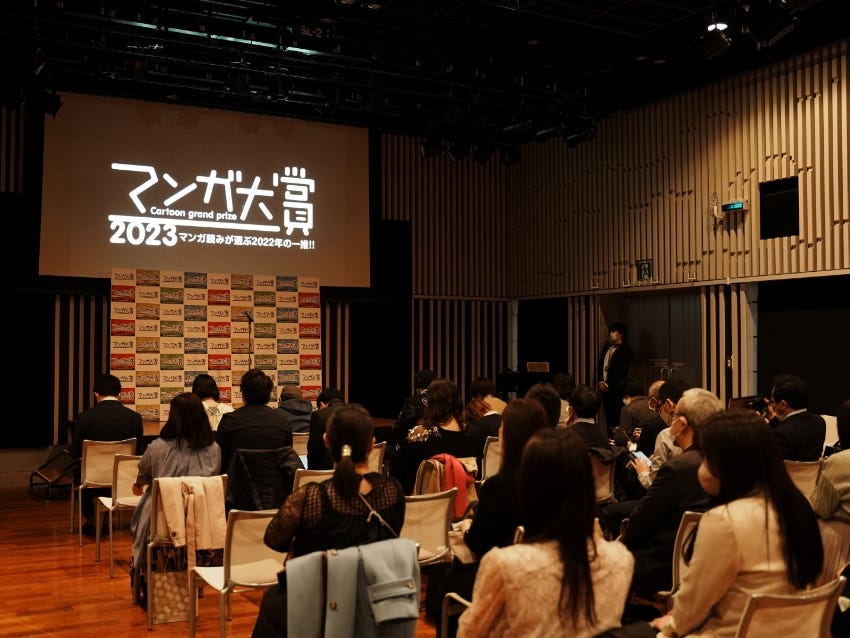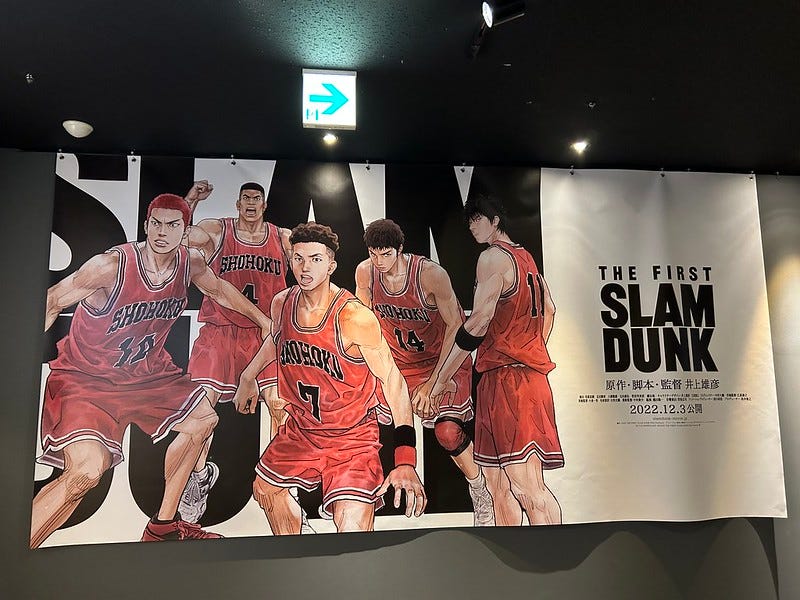Manga awards multiply in age of digital manga
Plus: Japanese printing giant diversifies into anime; Last year's highest-grossing anime film; Aniplex boss foresees more industry consolidation; and more
This is your weekly Animenomics briefing, covering the business of anime and manga. Today is Wednesday, February 7, 2024.
In case you missed it: Crunchyroll announced on Monday the release of its app for Samsung smart TV models in the United States made between 2017 and 2023.
Animenomics reported last month that Crunchyroll has been reinvesting in engineering teams to make its platform available on more devices.
Digital manga is proliferating, and so are manga awards

As manga sales grew rapidly on digital platforms, publishers have been holding more contests in the last decade to discover up-and-coming writers and artists, but some observers argue the industry now has too many awards.
Why it matters: Traditional manga awards can inadvertently become gatekeepers at a time when manga is getting more diverse in the shift from print to digital, an Oricon News editorial writes.
Driving the story: Comic Cmoa, one of Japan’s largest e-book platforms, named winners of the seventh annual Electronic Comic Prize last month, which saw the highest reader participation to date – 2.5 million votes.
“As a long-established company that has been around since the early days of digital comics, we had a sense of mission to make them more exciting,” Cmoa sales planning executive Tomoko Tada told Oricon News.
While traditional manga awards would require readers to buy print volumes to cast votes, digital manga readers can cast votes after reading free previews, lowering the barrier of entry for newer titles.
Zoom out: Public voting has become commonplace in manga awards after it was introduced in Takarajimasha’s monthly and annual manga rankings in 2005.
E-book platform BookLive ventured further into public voting by launching the Magademy Award in 2021 for naming the best manga characters.
Contrary to publisher-sponsored awards decided by judges, reader-voted rankings present manga recommendations through word of mouth.
Yes, but: Oricon News notes that some readers believe there are so many awards now that they no longer see any special features in the winners.
Between the lines: Traditional manga awards are also adapting as manga moves from magazines to apps, blurring the boundaries among reader demographics.
Publishing giant Shogakukan stopped using demographic categories such as boys’, girls’, and children’s manga for its 69th annual manga awards this year.
Printing giant diversifies into anime to sustain profits
Japan’s declining domestic print publishing market is pushing printing giant Dai Nippon Printing to diversify into other business areas like anime investment and production.
Why it matters: DNP is the world’s largest printing company, but profits from its publishing and content-related business have declined from 40 percent of the company’s total to 30 percent in 20 years, the Nikkei financial newspaper reports.
What’s happening: DNP said in December that Imagica, a video production and post-production company, will leverage technology developed by DNP to create short animations that it calls “light anime”.
Animations will be created from digitized manga drawings, eliminating the need for manual drawing and coloring, while voice actors provide voices.
This production method is estimated to cost one-tenth of a typical television anime series, so publishers and networks will be able to invest in more productions.
The details: DNP wants to produce as many as 500 “light anime” episodes a year by the end of the coming fiscal year.
The 10-minute episodes are designed to be easily viewed on a mobile device during commutes, following the trend of digital vertically-scrolling manga.
What they’re saying: “We have no intention of stopping paper printing just because the publishing market has shrunk,” DNP’s publishing business head Nobuyuki Asaba emphasized to the Nikkei.
Asaba believes DNP has a symbiotic relationship with publishers and authors, and withdrawing from printing would reduce the amount of content that can be adapted into anime and other screen productions.
Clippings: ‘Slam Dunk’ is Japan’s top anime film in 2023

Anime films made up one-third of Japan’s best-selling films of 2023, defined as having earned at least ¥1 billion (US$6.7 million) in the domestic box office, says the Motion Picture Producers Association of Japan. (Animation Business Journal)
South Korean webtoons are gaining traction among Japanese readers thanks to localized versions published on LINE Manga and Piccoma, the Japanese services of Naver Webtoon and Kakao Webtoon, respectively. (The Korea Times)
Manga titles accounted for 17 of the top 20 adult graphic novels sold in the United States last year, according to point-of-sale data from Circana BookScan, which covers 85 percent of the U.S. trade print book market. (ICv2)
Cyberpunk manga Akira’s iconic Kaneda motorcycle is being replicated as a hybrid electric vehicle by Barcelona-based art studio Bel&Bel, which previously made a replica of Dragon Ball’s Capsule No. 9 motorcycle. (Forbes)
This year’s AnimeJapan exhibition in Tokyo will hold an in-person business program for the first time in five years. (Press release)
Aniplex boss sees more anime industry consolidation
“In the end, the sense of belonging of anime creators toward anime studios is different between Japan and the United States. In Japan, there are many freelance animators, but in the United States, many are affiliated with studios. However, anime has become a big business in Japan, and I personally think that the anime industry will consolidate and become integrated in the future. The number of animators belonging to studios is gradually increasing, and we are getting closer to creating works in a structured way.”
— Atsuhiro Iwakami, president of anime production company Aniplex, a Sony subsidiary
Context: Iwakami spoke to the Nikkei on the anime industry’s evolution since late-night anime programs gained popularity on television networks more than a decade ago.
Iwakami believes Japan is still very reliant on auteur-driven anime IPs, which is both a strength and a challenge compared to other countries that produce content more efficiently through creative teams.
Of note: Aniplex is not yet ready to use artificial intelligence more widely, says Iwakami, because of doubts surrounding its commercial viability due to copyright and ethical concerns.
Manga artist death raises scrutiny of screen adaptations

Japan’s entertainment industry has been in shock over the last week after manga artist Hinako Ashihara was found dead following a dispute with the Nippon TV network, which was adapting her Sexy Tanaka-san manga for television.
Why it matters: The tragedy has exposed a rift between manga creators and the production teams that adapt their works for television and film.
Catch up quick: Ashihara accused Nippon TV in a blog post last month of failing to uphold an agreement to faithfully adapt her manga for a live-action series.
Ashihara stepped in to write the final two episodes after disagreeing with the removal of scenes and changes in the characterization of the protagonists.
The dispute spilled over to social media as users supporting Ashihara and screenwriter Tomoko Aizawa criticized each side for acting in bad faith.
Ashihara posted an apology on X (or Twitter) over the incident on January 28 and was found dead the next day in a suspected suicide.
Where things stand: A statement released by Nippon TV expressing condolences for Ashihara’s death also downplayed the dispute, leading to criticism from many social media users.
The Sports Nippon newspaper reports that Shogakukan, which publishes the Sexy Tanaka-san manga, has no plans to address the dispute directly to respect the wishes of Ashihara’s family for privacy.
The Japan Cartoonists Association published a statement encouraging manga artists to contact the group for assistance with contract disputes.
Bottom line: “It’s important [for production teams] to properly discuss how the original work will be changed while considering the artist’s intentions.” television industry journalist Tomoko Hasegawa told The Mainichi newspaper.
In the United States, the Suicide & Crisis Lifeline can be reached by dialing 988. In Japan, the TELL Lifeline service is can be reached at 03-5774-0992. A longer list of helplines by country is available from Befrienders Worldwide.
Animenomics is an independently-run and reader-supported publication. If you enjoyed this newsletter, consider sharing it with others.


